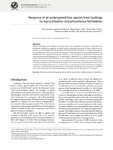Use este identificador para citar ou linkar para este item:
http://www.alice.cnptia.embrapa.br/alice/handle/doc/1010101Registro completo de metadados
| Campo DC | Valor | Idioma |
|---|---|---|
| dc.contributor.author | OLIVEIRA, J. R. G. de | pt_BR |
| dc.contributor.author | SILVA, E. M. e | pt_BR |
| dc.contributor.author | RIOS, T. T. | pt_BR |
| dc.contributor.author | MELO, N. F. de | pt_BR |
| dc.contributor.author | MELO, A. M. Y. | pt_BR |
| dc.date.accessioned | 2015-02-27T11:11:11Z | pt_BR |
| dc.date.available | 2015-02-27T11:11:11Z | pt_BR |
| dc.date.created | 2015-02-27 | pt_BR |
| dc.date.issued | 2015 | pt_BR |
| dc.identifier.citation | Acta Botanica Brasilica, Belo Horizonte, v. 29, n. 1, p. 94-102. 2015. | pt_BR |
| dc.identifier.uri | http://www.alice.cnptia.embrapa.br/alice/handle/doc/1010101 | pt_BR |
| dc.description | Schinopsis brasiliensis is an endangered tree species found in the Caatinga biome. It presents a characteristic slow development and difficult propagation, although it has been traditionally exploited in the region. Application of arbuscular mycorrhizal fungi (AMF) and phosphorus (P) fertilization may be beneficial to S. brasiliensis development at the seedling stage, which at the same time may help species conservation and the recovery of degraded areas in the Caatinga biome. We assessed the response of S. brasiliensis to AMF inoculation (Claroideoglomus etunicatum and Acaulospora longula) and P fertilization (0, 12, 24, and 48 mg dm −3 addition of P 2 O 5 ). S. brasiliensis responded positively to both AMF inoculation and P fertilization. At low P concentrations, the inoculated plants showed higher leaf area and enhanced vegetative development, nutrient content and biomass production compared with non-inoculated plants. Conversely, increasing levels of P fertilization decreased the level of mycorrhizal colonization, plant responsiveness to inoculation, and spore production in C. etunicatum . Thus, P concentrations were able to influence the response of S. brasiliensis to mycorrhization and responsiveness to increased mycorrhization with the decrease in P availability. These results showed that mycorrhizal symbiosis plays an essential role in the development of S. brasiliensis. | pt_BR |
| dc.language.iso | eng | eng |
| dc.rights | openAccess | eng |
| dc.subject | Planta da Caatinga | pt_BR |
| dc.subject | FMA | pt_BR |
| dc.subject | Fungo micorrízico arbuscular | pt_BR |
| dc.subject | Planta nativa | pt_BR |
| dc.subject | Arbuscular Mycorrhizal fungi | pt_BR |
| dc.subject | Caatinga biome | pt_BR |
| dc.title | Response of an endangered tree species from Caatinga to mycorrhization and phosphorus fertilization. | pt_BR |
| dc.type | Artigo de periódico | pt_BR |
| dc.date.updated | 2016-05-30T11:11:11Z | pt_BR |
| dc.subject.thesagro | Baraúna | pt_BR |
| dc.subject.thesagro | Caatinga | pt_BR |
| dc.subject.thesagro | Schinopsis Brasiliensis | pt_BR |
| riaa.ainfo.id | 1010101 | pt_BR |
| riaa.ainfo.lastupdate | 2016-05-30 | pt_BR |
| dc.identifier.doi | 10.1590/0102-33062014abb3420 | pt_BR |
| dc.contributor.institution | JOÃO RICARDO GONÇALVES DE OLIVEIRA, UFPE; ELIENE MATOS E SILVA, UFPE; THAÍS TEIXEIRA RIOS, UFPE; NATONIEL FRANKLIN DE MELO, CPATSA; ADRIANA MAYUMI YANO MELO, UNIVASF. | pt_BR |
| Aparece nas coleções: | Artigo em periódico indexado (CPATSA)  | |
Arquivos associados a este item:
| Arquivo | Descrição | Tamanho | Formato | |
|---|---|---|---|---|
| Natoniel2015.pdf | 1.73 MB | Adobe PDF |  Visualizar/Abrir |









